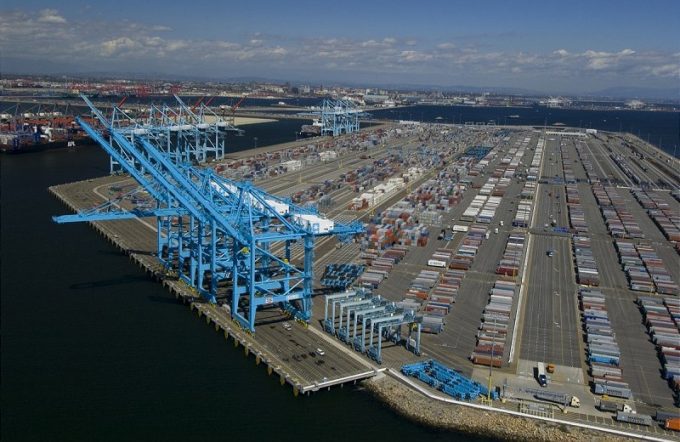Bangladesh looks at demurrage waiver as containers pile up in Chittagong
The Chittagong port yards now have close to 40,000 teu of containers, mainly loaded with ...
TFII: SOLID AS USUALMAERSK: WEAKENINGF: FALLING OFF A CLIFFAAPL: 'BOTTLENECK IN MAINLAND CHINA'AAPL: CHINA TRENDSDHL: GROWTH CAPEXR: ANOTHER SOLID DELIVERYMFT: HERE COMES THE FALLDSV: LOOK AT SCHENKER PERFORMANCEUPS: A WAVE OF DOWNGRADES DSV: BARGAIN BINKNX: EARNINGS OUTODFL: RISING AND FALLING AND THEN RISING
TFII: SOLID AS USUALMAERSK: WEAKENINGF: FALLING OFF A CLIFFAAPL: 'BOTTLENECK IN MAINLAND CHINA'AAPL: CHINA TRENDSDHL: GROWTH CAPEXR: ANOTHER SOLID DELIVERYMFT: HERE COMES THE FALLDSV: LOOK AT SCHENKER PERFORMANCEUPS: A WAVE OF DOWNGRADES DSV: BARGAIN BINKNX: EARNINGS OUTODFL: RISING AND FALLING AND THEN RISING

Container imports to the US from Asia in December were 30% higher than in the same month of 2017, but the tariff-beating rush of Chinese goods, the main cause of the surge, has reportedly “overwhelmed” the two main west coast gateways.
According to PIERS data, analysed by Alphaliner, US imports from Asia exceeded 1.5m teu in December – a new high, with a new record also set by the 1.09m teu of exports from China, 72% of all ex-Asia traffic.
December’s volumes pushed the full-year 2018 transpacific growth to 8.3%, the highest since 2010.
The port of Los Angeles said it moved more containers last year than ever before, 9,458,749 teu, helped by a 22% import surge in December, while neighbouring Long Beach said it was “virtually certain” it would eclipse its record of 7,544,507 teu.
“Last year’s exceptional volumes were mainly driven by US importers’ front loading efforts aimed at beating the 1 January deadline for a 25% tariff on Chinese imports,” said Alphaliner.
However, the outlook for transpacific cargo demand is unclear, due to the unresolved US-China trade spat ,with the clock ticking on the imposition of a 25% tariff on some 5,700 Chinese imports, due on 2 March.
In view of the uncertainty, and evidence of softer demand so far this month, carriers have “remained very cautious” said Alphaliner, with for example the Ocean Alliance’s new ‘Day 3’ network focusing its growth strategy instead on the Asia-North Europe, -Med and -Middle East trades.
Notwithstanding the likely weaker demand on the transpacific after the Chinese New Year, which commences on 5 February, the impact of the Chinese import front loading of cargo on the US west coast port complex of Los Angeles and Long Beach has resulted in severe gridlock at the terminals and greatly increased dwell times.
A combination of the import demand surge, which prompted carriers to inject 22 extra loaders in the final weeks of 2018, as well as upsizing some of their fleet, has exposed the fragile nature of the LA/LB intermodal infrastructure.
Equipment, particularly chassis, shortages have plagued the San Pedro Bay ports for years, but anecdotal reports to The Loadstar suggest the situation has deteriorated significantly in the past month.
“It’s a vicious circle,” one BCO told The Loadstar. “Containers are sitting on the terminals much longer, aggravating the chassis shortage further.”
He said he believed the port complex was “overwhelmed” and complained he was getting “stung” with additional demurrage and detention charges, incurred through no fault of his.
With spot rates on the transpacific skyrocketing, at one stage as much as 100% higher than a year ago, carriers have sought ways to increase their carrying capacity by increasing the size of the vessels deployed on the tradelane.
For example, Maersk Line replaced two 13,000 teu ships with two 17,800 teu ULCVs that had been temporarily idle on the Asia-North Europe trade, while OOCL replaced an 8,800 teu vessel with a 13,200 teu ship.
It is understood that the much enlarged working programmes of these ships dumping considerably greater volumes per call put unsustainable pressure on the labour situation at the LA/LB terminals, causing containers to be discharged at alternative quays, further exacerbating the chassis crisis.
Comment on this article